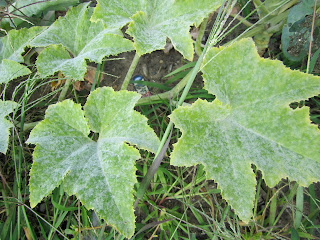It seems once again this year we have some crops affected with powdery mildew. We spotted cucumber and melon leaves covered in the tall tell signs. Luckily it has struck later in the growing season and hasn't taken over the crops entirely.
We did some research (http://organicgardening.about.com/od/diseases/p/PowderyMildew.htm) and discovered powdery mildew thrives in temperatures between 60 and 80 degrees. Dry, shady conditions are ideal, as are areas with poor air circulation. Planting disease resistant cultivars and making sure you allow for good air flow are two ways to guard against powdery mildew. Inspect plants regularly during warm, dry conditions, and remove any leaves that show signs of infection. Destroy (do not compost!) infected plant parts. A spray made with baking soda, if applied weekly at the first signs of infection, can protect plants against further damage. Plants that are badly infected should be ripped out and destroyed to prevent the disease from spreading further.
A commercially available organic option is Neem oil, which both treats existing powdery mildew and protects the plant against further infection. (One of our gardeners uses Neem oil spray on aphids in her garden, and has found it to be really effective!)
A commercially available organic option is Neem oil, which both treats existing powdery mildew and protects the plant against further infection. (One of our gardeners uses Neem oil spray on aphids in her garden, and has found it to be really effective!)
Interestingly enough, the most effective measure in preventing and treating powdery mildew is to spray the foliage of your plants daily with plain water from the hose. Powdery mildew hates water! The only caveat with this method is to be sure you do it early in the day so that the foliage completely dries before cooler evening temperatures arrive, otherwise you may invite other fungal diseases, such as black spot, into your garden.
If your garden has fallen victim to powdery mildew, how have you treated it?
We would love to hear from you!



No comments:
Post a Comment